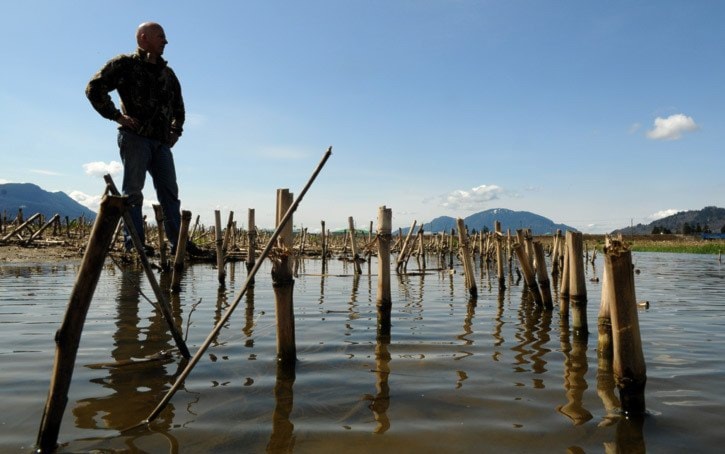A cool, rainy spring can stop some local farmers in their tracks.
Ian Sparkes of Sparkes Corn Barns has been looking to the skies for drier weather so he can get his early sweet corn planted in Chilliwack.
“I can’t plow the field this way,” Sparkes told The Progress, with more than a hint of frustration in his voice. “So we’re trying to pump out this swale.”
The low-lying field on Luckakuck Way that he’s been trying to plant, is normally dry this time of year.
It’s been quite a cool and wet spring, so it’s understandable that most of the south coast is a little “waterlogged” right now, said Environment Canada meteorologist Doug Lundquist.
“We had a wetter than normal March, and in April so far we’ve had half our rainfall total in the first 12 days or so,” he told The Progress.
About 70 mm had fallen in the month of April by Wednesday, where a typical April would see 120 mm in total. But the real culprit was likely the 44 millimetres that soaked on the region on April 4 and April 5 alone.
“It came all at once over those two very wet days,” Lundquist said.
“We’ll have close to normal daytime high temperatures next week, but no sun to dry things out, unfortunately. There could always be a few sunny breaks.”
It’s the La Niña effect with its colder than normal winter, as opposed to an El Niño system, that’s still impacting coastal weather systems, Lundquist pointed out.
“It’s one of the main factors in spring remaining on the cool and wet side,” he said. “That’s why it might seem a little severe.”
Sparkes specializes in sweet corn these days, but he is also a custom planter for field corn. Normally he’d take a cover crop off the field before planting, but not this year.
“It’s late so we’ll plow them under early and all the field corn will go in at the same time.”
Organic farmer Mary Forstbauer said this year they’re putting in more greenhouse structures so they can get started earlier. They rarely plant this early in open fields since the soil is still pretty cold, but sometimes they plant peas or broad beans if they can manage.
But not this spring.
“The fields are flooded,” she said. “There is no way a tractor could effectively drive over the fields.”
And even if the fields could take the weight of the tractor, it could damage the soil, creating even more hardship.
Weather is always a factor in outdoor agri-food production. What the farmers say they need now is several dry days out on the fields to till, and prepare the soil for planting.
“The rain has stopped us cold,” Sparkes said earlier this week. “We have some corn that’s up now in other fields, but we have a very small window to do any work since it’s been constantly raining.”
The forecast for next week is not looking so hot, either. At least not at this point.
“There’s not a lot of sun in store, and it looks like more of the same with wet and cloudy conditions,” said the weather man.
A steep curve toward warmer temperatures is on its way, he said, but it will take its own sweet time.
